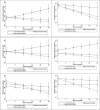Socio-economic inequalities in suffering at the end of life among advanced cancer patients: results from the APPROACH study in five Asian countries
- PMID: 32912232
- PMCID: PMC7488341
- DOI: 10.1186/s12939-020-01274-5
Socio-economic inequalities in suffering at the end of life among advanced cancer patients: results from the APPROACH study in five Asian countries
Abstract
Background: A systematic understanding of socio-economic inequalities in end-of-life (EOL) suffering among advanced cancer patients is required to inform efforts to reduce these inequalities as part of Universal Health Coverage goals.
Aims: To assess inequalities in multiple domains of EOL suffering among advanced cancer patients - physical, functional, psychological, social, and spiritual -, using two socio-economic status (SES) indicators, education and perceived economic status of the household.
Methods: We used cross-sectional data from surveys of stage IV cancer patients (n = 1378) from seven hospitals across five countries (China, Sri Lanka, India, Vietnam and Myanmar). We conducted separate multivariable linear regression models for each EOL suffering domain. We also tested interactions between the two SES indicators and between each SES indicator and patient age.
Results: Patients living in low economic status households /with fewer years of education reported greater suffering in several domains. We also found significant interaction effects between economic status of the household and years of education for all EOL suffering outcomes. Age significantly moderated the association between economic status of the household and social suffering and between years of education and psychological, social, and spiritual suffering (p < 0.05 for all).
Conclusion: Results highlight that SES inequalities in EOL suffering vary depending on the suffering domain, the SES indicator assessed, and by patient age. Greater palliative care resources for patients with low SES may help reduce these inequalities.
Keywords: Economic status; End of life; Inequalities; Metastasis.
Conflict of interest statement
The authors declare that they have no competing interests.
Figures
Similar articles
-
End of life experiences of patients with advanced cancer in Myanmar: Results from the APPROACH study.Asia Pac J Clin Oncol. 2020 Dec;16(6):333-339. doi: 10.1111/ajco.13373. Epub 2020 Jun 23. Asia Pac J Clin Oncol. 2020. PMID: 32573100
-
Health-related quality of life and its socio-economic and cultural predictors among advanced cancer patients: evidence from the APPROACH cross-sectional survey in Hyderabad-India.BMC Palliat Care. 2019 Nov 5;18(1):94. doi: 10.1186/s12904-019-0465-y. BMC Palliat Care. 2019. PMID: 31690311 Free PMC article.
-
Disparities in end-of-life outcomes among advanced cancer patients in Sri Lanka: Results from the APPROACH study.Palliat Support Care. 2022 Dec;20(6):832-838. doi: 10.1017/S147895152100167X. Palliat Support Care. 2022. PMID: 36942586
-
Socio-economic health differences in The Netherlands: a review of recent empirical findings.Soc Sci Med. 1992 Feb;34(3):213-26. doi: 10.1016/0277-9536(92)90264-q. Soc Sci Med. 1992. PMID: 1557663 Review.
-
Tackling socioeconomic inequalities and non-communicable diseases in low-income and middle-income countries under the Sustainable Development agenda.Lancet. 2018 May 19;391(10134):2036-2046. doi: 10.1016/S0140-6736(18)30482-3. Epub 2018 Apr 5. Lancet. 2018. PMID: 29627160 Review.
Cited by
-
Patient experience with cancer care in low- and middle-income Asian countries: a cross-sectional study of patients with advanced cancer.BMJ Glob Health. 2025 Jul 7;10(7):e017153. doi: 10.1136/bmjgh-2024-017153. BMJ Glob Health. 2025. PMID: 40623792 Free PMC article.
-
The Contribution of the European School Of Oncology Education to the Central Asian and Caucasian Regions.J Cancer Educ. 2022 Feb;37(1):224-229. doi: 10.1007/s13187-021-02072-5. Epub 2021 Jul 22. J Cancer Educ. 2022. PMID: 34292502
-
Integration of primary palliative care into geriatric care from the Indian perspective.J Family Med Prim Care. 2022 Sep;11(9):4913-4918. doi: 10.4103/jfmpc.jfmpc_399_22. Epub 2022 Oct 14. J Family Med Prim Care. 2022. PMID: 36505579 Free PMC article.
-
Dimensions of suffering and the need for palliative care: experiences and expectations of patients living with cancer and diabetes and their caregivers in Mexico - a qualitative study.BMJ Open. 2023 Dec 14;13(12):e075691. doi: 10.1136/bmjopen-2023-075691. BMJ Open. 2023. PMID: 38101838 Free PMC article.
-
Palliative and end-of-life care initiatives for people dying from cancer in India: a narrative review.Ecancermedicalscience. 2024 Dec 12;18:1822. doi: 10.3332/ecancer.2024.1822. eCollection 2024. Ecancermedicalscience. 2024. PMID: 40171455 Free PMC article. Review.
References
-
- Committee IMU. Sloan FA GH, editor. Cancer Control Opportunities in Low- and Middle-Income Countries. Washington (DC): The National Academies Press (U.S.); 2007. The Cancer Burden in Low- and Middle-Income Countries and How It Is Measured. - PubMed
-
- Krikorian A, Limonero JT, Maté J. Suffering and distress at the end-of-life. Psycho-Oncology. 2012;21(8):799–808. - PubMed
-
- Wilson KG, Chochinov HM, McPherson CJ, LeMay K, Allard P, Chary S, et al. Suffering with advanced cancer. J Clin Oncol. 2007;25(13):1691–1697. - PubMed
-
- Knaul FM, Farmer PE, Krakauer EL, De Lima L, Bhadelia A, Kwete XJ, et al. Alleviating the access abyss in palliative care and pain relief—an imperative of universal health coverage: the lancet commission report. Lancet. 2018;391(10128):1391–1454. - PubMed
Publication types
MeSH terms
LinkOut - more resources
Full Text Sources
Medical




